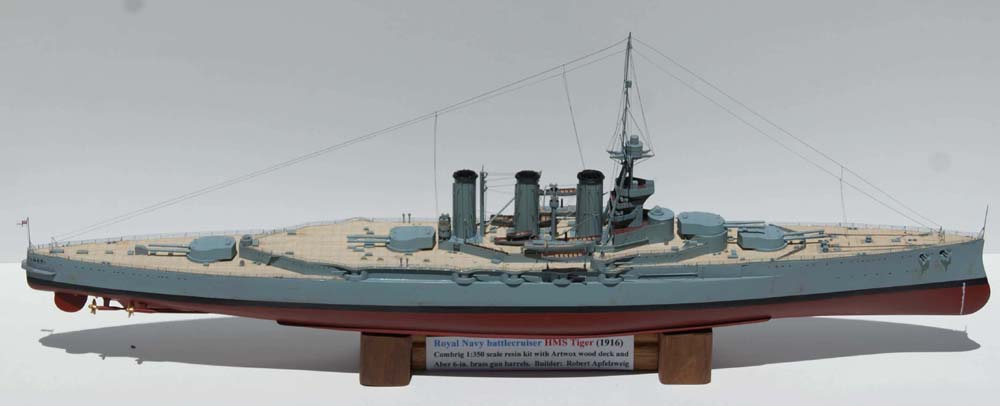
1/350 HMS Tiger (Combrig)
|
by Robert Apfelzweig |

1/350 HMS Tiger (Combrig)
HMS Tiger was the last battlecruiser built for the Royal Navy prior to the start of the First World War, and her design (originally intended as the fourth of the Lion class) was significantly modified by the success of the recent Vickers-built Kongo for the Japanese Navy. She fought well at Jutland, suffering only minor damage, and was retained in the post-war Royal Navy until scrapped in the early 1930's under the terms of the London Naval Treaty. She was also the last capital ship in the Royal Navy to be powered by coal.Combrig's kit builds into a sleek, handsome model, but is not without a number of problems. The upper and lower hull halves do not always fit together well along the seams and considerable puttying and sanding was necessary. I used the excellent Artwox wood deck (one of the few available from this manufacturer that is designed to match with a resin hull) but the deck was a little short by about 1 mm or so in places and some filling with extra deck material (of which there is plenty) was needed to align everything properly. Although this is a relatively recently released model, the kit suffers from Combrig's usual shortcomings -- instructions are somewhat ambiguous as to precise attachments of parts (although many of the smaller, and similar, parts such as ventilators are numbered for easier identification), there is no painting scheme, the modeler must provide his own plastic or brass rods (the length and diameters are provided in the instructions) for the masts, yardarms, propeller shafts and booms, and the model as completed has a good deal of empty deck space where there may have been additional gear and equipment. There are also two extra bridge decks, presumably for those who wish to model a later (post-1917) version of the Tiger, but no indication of where they would go, and there are no additional parts that one would need to modify or replace the fighting top and add a mainmast. The instructions do show a top and starboard diagram of the ship, and this aids in rigging, if not in precise parts placement. I utilized Siegfried Breyer's book "Battleships and Battlecruisers, 1905 - 1970" as a reference, partly because the Tiger underwent several refits and, though I portrayed the ship essentially as the kit intended (ca. 1916, post-Jutland), there was uncertainty as to how many 3-in deck guns should be used (the kit states 6, but I could find photographic evidence of only 4) and where certain deck fixtures should go (e.g., the kit has what seems to be a half-dome-shaped ventilator placed just aft of the third, or Q, turret, whereas Breyer places it directly aft of the 13.5-in. gun barrels of the fourth, or X, turret).
There is a good high-resolution online image of the Tiger in this time period, and this helped considerably in deciding on the proper rigging scheme as well as some bridge details. The Combrig kit's limited photoetch set provides no inclined ladders or railings; I had plenty of both in my spare parts stash but was uncertain where to place the former -- that online photo indicates that some should connect the bridge decks, but the decks in the kit had no openings for them and so I omitted them from the bridge. I had to do some scratchbuilding to fill everything out that I could, and used Aber brass 6-in. guns (originally intended for the Kongo-class Japanese battleships but apparently identical in size and shape to the contemporary British guns). Also, the Tiger had twin rudders, but the kit only provides one and has it located on the centerline of the stern; I used it as a template to make a second rudder from Evergreen plastic sheet and installed both in the positions I felt they should go. Rigging was made from stretched black plastic sprue.
Paint color is always a problem with World War I ships; the Royal Navy used a dark grey before the war and a lighter grey during the war; I somewhat arbitrarily selected Tamiya Medium Gray AS28 from a spray can and mixed up a similar color from Tamiya acrylic paints for touch-ups; for the funnel tops and wide boot topping, Tamiya Flat Black, and the lower hull was sprayed with Liquitex Cadmium Medium Red Hue.
